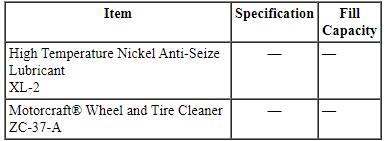SPECIFICATIONS
Material

General Specifications

Torque Specifications

a Refer to the procedure in this section.
DESCRIPTION AND OPERATION
Wheels And Tires
Safety Precautions
WARNING: Vehicle may have multiple drive wheels. Do not use engine to power the driveline unless all drive wheels are elevated off the ground. Drive wheels in contact with ground could cause unexpected vehicle movement. Failure to follow this instruction may result in serious personal injury.
WARNING: Always match the tire size to the wheel size during assembly. Incorrect matching can result in tire bead damage or tire separation from the wheel. Failure to follow this instruction may result in serious personal injury to technician or vehicle occupant(s).
WARNING: Before servicing any tire, ask the customer if anyone injected a tire sealant into the tire. Tire sealants may be flammable and can burn or explode if exposed to an ignition source. Failure to follow this instruction may result in serious personal injury.
WARNING: Replacement wheels must be equivalent to the original equipment wheels in:
- load carrying capacity.
- diameter, width and offset.
- pilot hole and bolt circle.
WARNING: Never use wheels different than the original equipment. Additionally, never use wheel nuts different than the original equipment. Failure to follow these instructions may result in damage to the wheel or mounting system. This damage could cause the wheel to come off while the vehicle is being driven, which could result in serious personal injury or death to vehicle occupant(s).
WARNING: Wear eye and ear protection when servicing a vehicle. Failure to follow this instruction may result in serious personal injury.
WARNING: Keep eyes away from valve stem when deflating tires. Reduce air pressure in tire as much as possible by pushing in valve core plunger prior to removing the core. Escaping air can carry particles that can injure the eyes. Failure to follow these instructions may result in serious personal injury.
WARNING: Only use replacement tires that are the same size, load index, speed rating and type (such as P-metric versus LT-metric or all-season versus all-terrain) as those originally provided by Ford. The recommended tire and wheel size may be found on either the Safety Compliance Certification Label or the Tire Label, which is located on the B-pillar or edge of the driver's door. If the information is not found on these labels, consult a Ford dealer. Use of any tire or wheel not recommended by Ford can affect the safety and performance of the vehicle, which could result in an increased risk of loss of vehicle control, vehicle rollover, personal injury and death. Additionally, the use of non-recommended tires and wheels could cause steering, suspension, axle or transfer case/power transfer unit failure.
NOTICE: Do not clean aluminum wheels with steel wool, abrasive-type cleaners or strong detergents or damage to the wheel finish may occur. Use Wheel and Tire Cleaner ZC-27-A or -B or equivalent.
Factory-installed tires and wheels are designed to operate satisfactorily with loads up to and including full-rated load capacity when inflated to recommended inflation pressures.
Correct tire pressure and driving techniques have an important influence on tire life. Heavy cornering, excessively rapid acceleration and unnecessary sharp braking increase tire wear.
To equalize tire wear, the tires should be rotated at recommended intervals.
Tire Pressure Monitoring System (TPMS)
The TPMS includes:
- the Body Control Module (BCM) located behind the left cowl.
- the Tire Pressure Monitor (TPM) module located behind the left quarter trim.
- four tire pressure sensors.
- an Instrument Panel Cluster (IPC) warning indicator.
- a message center.
Tire Pressure Monitoring Module
The TPM module is a radio receiver that collects the tire pressure data from the TPM tire pressure sensors. The TPM module passes the tire pressure data to the BCM where the BCM applies a predetermined pass fail criteria.
The BCM compares the information of each tire pressure sensor transmission against a pressure limit. If the BCM determines the tire pressure has fallen below the low limit, the BCM communicates this to the IPC on the vehicle communication bus.
Tire Pressure Monitor (TPM) Tire Pressure Sensor
The BCM monitors the air pressure in the 4 tires with tire pressure sensors. The sensors transmit radio frequency signals to the TPM module approximately every 60 seconds when the vehicle speed exceeds 32 km/h (20 mph).
The tire pressure sensors are battery operated and are mounted to the valve stem.
Instrument Panel Cluster (IPC) and Message Center
The IPC illuminates the TPM indicator when it receives a message from the BCM and displays the appropriate message(s) in the message center.
 Wheels and Tires
Wheels and Tires
...
 Diagnosis and Testing
Diagnosis and Testing
Wheels And Tires
Special Tool(s)
Inspection and Verification
WARNING:
Vehicle may have multiple drive wheels. Do not use engine to power the driveline
unless all drive wheels are elevated off the g ...
Other materials:
Tire care
Information About Uniform Tire Quality Grading
Tire Quality Grades apply to new
pneumatic passenger car tires. The Tire
Quality Grades can be found where
applicable on the tire sidewall between
tread shoulder and maximum section
width. For example:
• Treadwear 200 Traction AA Temperature ...
Specifications, Description and Operation, General Procedures
SPECIFICATIONS
Material
General Specifications
Torque Specifications
a Tighten to 10 Nm (89 lb-in) plus an additional 720 degrees.
b Tighten to 16 Nm (142 lb-in) plus an additional 180 degrees.
c Refer to the procedure in this section.
d Tighten to 5 Nm (44 lb-in) plus ...
Fuel consumption
Filling the Tank
The advertised capacity is the indicated capacity and the empty reserve
combined. Indicated capacity is the difference in the amount of fuel in a
full tank and a tank when the fuel gauge indicates empty. Empty reserve
is the amount of fuel in the tank after the fuel gauge indica ...
